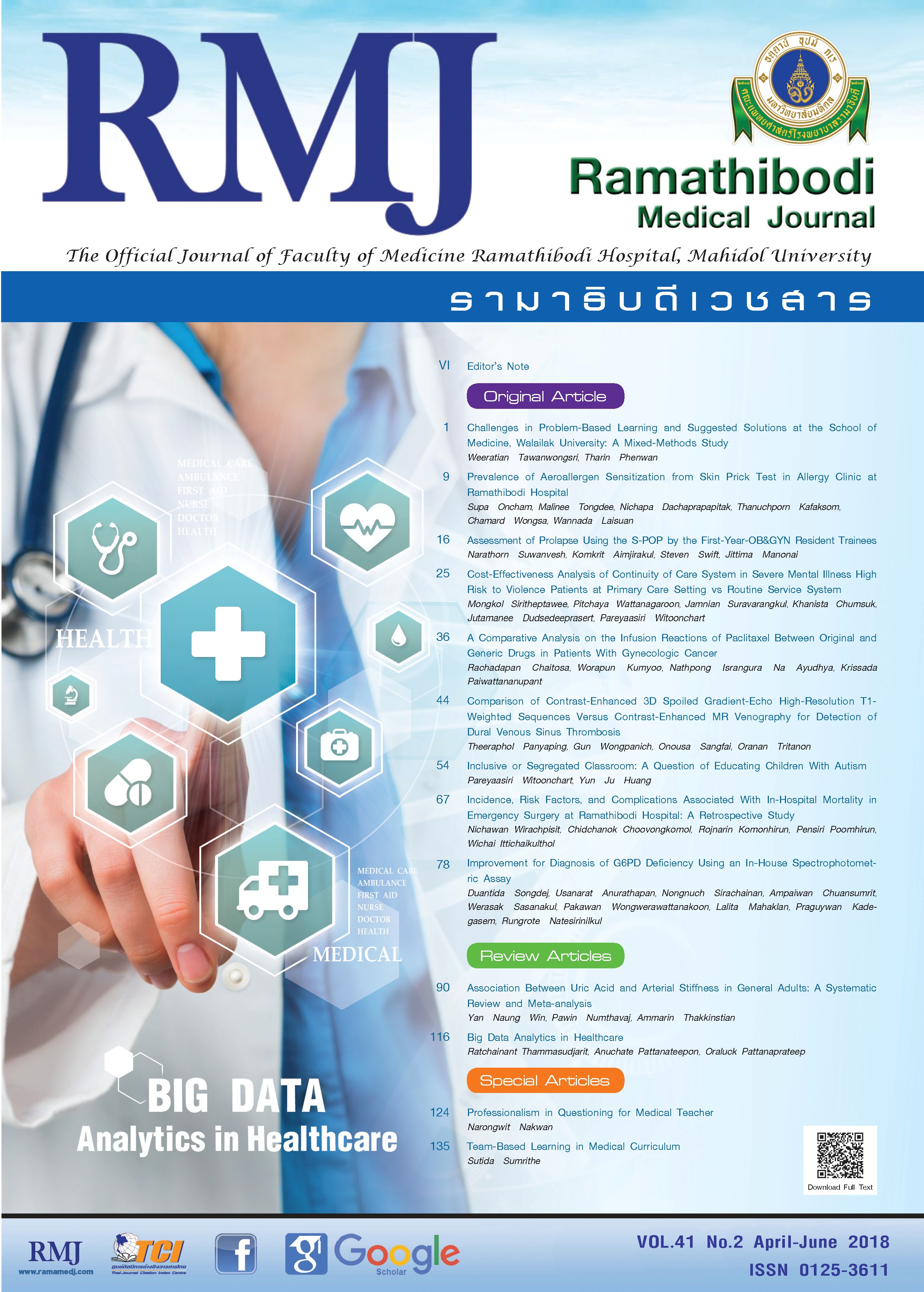Team-Based Learning in Medical Curriculum
Main Article Content
Abstract
The learning process in medical curriculum needs continuous improvement to accomplish the goal of producing graduates adapt ability to the complexity of changing health system. Physicians are required to have competencies in medical knowledge, communication skill, and multidisciplinary teamwork skill. Nowadays, team-based learning (TBL) is widely used in medical schools because it has positive effects on developing critical thinking and working as a team member. The learning process is designed to be student-centered approach, where team of learners are assigned to study the lesson before class. This allows teachers to spend more time in the classroom activities to promote higher level of thinking than lecturing. In order to make TBL effectively, medical schools should have administrative planning, faculty development and learning resources development which are critical factors for success of Team-Based Learning.
Article Details
References
Lopez AD, Mathers CD, Ezzati M, Jamison DT, Murray CJ. Global and regional burden of disease and risk factors, 2001: systematic analysis of population health data. Lancet. 2006;367(9524):1747-1757. doi:10.1016/S0140-6736(06)68770-9.
Plsek PE, Greenhalgh T. Complexity science: The challenge of complexity in health care. BMJ. 2001;323(7313):625-628.
Morrison G, Goldfarb S, Lanken PN. Team training of medical students in the 21st century: would Flexner approve? Acad Med. 2010;85(2):254-259. doi:10.1097/ACM.0b013e3181c8845e.
Flexner A. Medical education in the United States and Canada. From the Carnegie Foundation for the Advancement of Teaching, Bulletin Number Four, 1910. Bull World Health Organ. 2002;80(7):594-602.
Frank JR, Snell LS, Cate OT, et al. Competency-based medical education: theory to practice. Med Teach. 2010;32(8):638-645. doi:10.3109/0142159X.2010.501190.
Irby DM, Cooke M, O'Brien BC. Calls for reform of medical education by the Carnegie Foundation for the Advancement of Teaching: 1910 and 2010. Acad Med. 2010;85(2):220-227. doi:10.1097/ACM.0b013e3181c88449.
Frenk J, Chen L, Bhutta ZA, et al. Health professionals for a new century: transforming education to strengthen health systems in an interdependent world. Lancet. 2010;376(9756):1923-1958. doi:10.1016/S0140-6736(10)61854-5.
Sultan AS. The Flipped Classroom: An active teaching and learning strategy for making the sessions more interactive and challenging. J Pak Med Assoc. 2018;68(4):630-632.
Rajalingam P, Rotgans JI, Zary N, Ferenczi MA, Gagnon P, Low-Beer N. Implementation of team-based learning on a large scale: three factors to keep in mind. Med Teach. 2018:1-7. doi:10.1080/0142159X.2018.1451630.
Parmelee D, Michaelsen LK, Cook S, Hudes PD. Team-based learning: a practical guide: AMEE guide no. 65. Med Teach. 2012;34(5):e275-e287. doi:10.3109/0142159X.2012.651179.
Burgess Aw, McGregor DM, Mellis CM. Applying established guidelines to team-based learning programs in medical schools: a systematic review. Acad Med. 2014;89(4):678-688. doi:10.1097/ACM.0000000000000162.
Parmelee DX, Michaelsen LK. Michaelsen LK. Twelve tips for doing effective Team-Based Learning (TBL). Med Teach. 2010;32(2):118-122. doi:10.3109/01421590903548562.
Chen M, Ni C, Hu Y, et al. Meta-analysis on the effectiveness of team-based learning on medical education in China. BMC Med Educ. 2018;18(1):77. doi:10.1186/s12909-018-1179-1.




